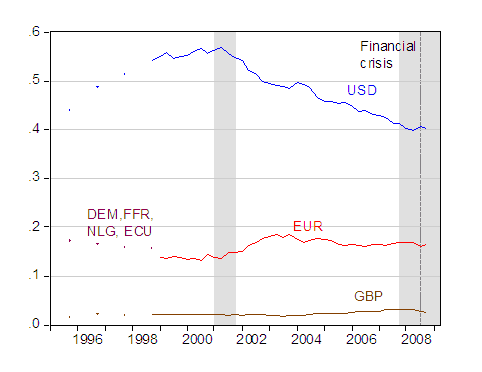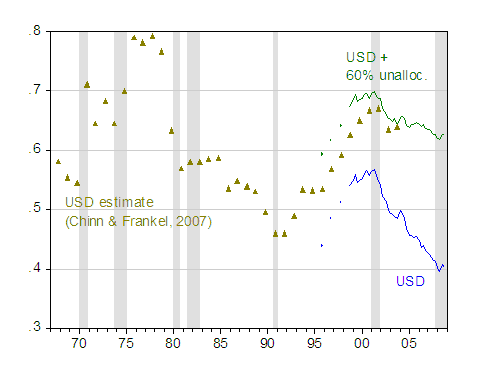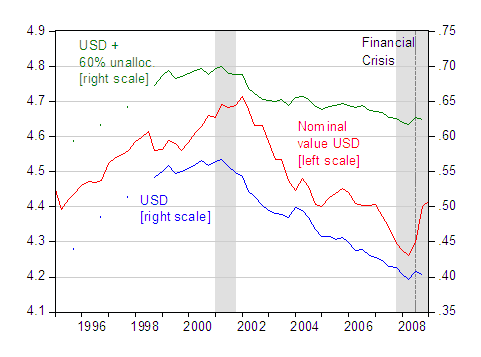Time to review trends in reserves, against the backdrop of financial crisis, recession, and dollar gyrations. (I’ll try to be original, but Brad Setser has been more diligent than I in covering these issues over the past few months. [0] [1] [2])
A few observations:
» Known dollar reserves as a share of world reserves appear to be falling.
» Total dollar reserves have likely not declined as precipitously.
» Even with the decline in the dollar share, it is probably not as low as it was during the early 1990’s.
» The dollar share is (mechanically) linked to the dollar’s value.
» Known dollar reserves at end-2008 are less than predicted by a historical correlation.
» But this differential is infinitesimal compared to the “unallocated” share of total reserves.
Consider first the IMF statistics on known dollar, euro (and euro legacy), and pound reserves.

Figure 1: US dollar (blue), euro (red), sum of Deutsche mark, French franc, Dutch guilder, ECU (purple), and British pound (brown) shares of total reserves. NBER defined recession dates shaded gray. Source: IMF, COFER, March 31, 2009, NBER and author’s calculations.

Figure 2: US dollar (blue), US dollar plus 60% of unallocated reserves (green), and IMF-estimated shares of total reserves (chartreuse triangles). NBER defined recession dates shaded gray. Source: IMF, COFER, March 31, 2009, and Chinn-Frankel (2007), NBER and author’s calculations.
The triangles denote IMF-estimated holdings of US dollars. Before the COFER database was publicized, the IMF estimated aggregate currency holdings, guessing the portfolio of central banks that did not report the currency composition of their holdings. These figures were reported in the Annual Reports. Notice that the 2004 estimate pretty closely matches the guess that I make, namely that 60% of unallocated holdings are in US dollars. There is, of course, no guarantee that this proportion still holds.

Figure 3: US dollar (blue, right scale), US dollar plus 60% of unallocated reserves (green, right scale), and nominal value of US dollar against major currencies (red, left scale). NBER defined recession dates shaded gray. Source: IMF, COFER, March 31, 2009, Federal Reserve via FREDII, NBER and author’s calculations.
Why has the dollar’s share declined? Some proportion is likely due to the decline in the value of the dollar, since the calculation of the value of reserves is made using exchange rates. Of course, a decline in the share is not required, since central banks could be optimizing by keeping the currency shares constant.
Each one percent decline in the dollar’s value is associated with a 0.91 percent decrease in the dollar value of US dollar reserves in the period up to 2008 Q2. Based upon this historical correlation, the share of US dollars in total holdings should have been about 2.7 percentage points. Of course, this is small compared to the 37.2 percentage points of total reserves that are unknown in terms of currency composition.
That all being said, we want to be wary of what is coming down the pike. Brad Setser has a good review of possible triggers of a dollar currency crisis, that covers similar ground that I have: [2] [3] [4].
Disclaimer: This page contains affiliate links. If you choose to make a purchase after clicking a link, we may receive a commission at no additional cost to you. Thank you for your support!



Leave a Reply